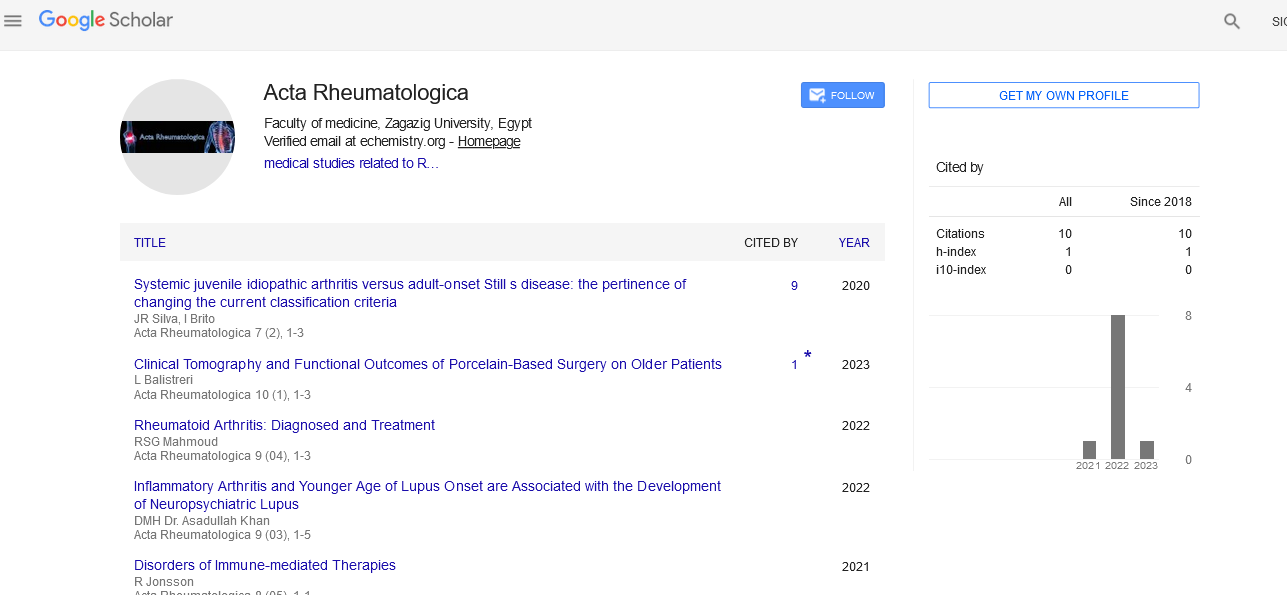Perspective - (2024) Volume 11, Issue 2
Dolor Lumbar: Understanding and Managing Lower Back Pain
Valeria Ciaffaglione*
Department of Health Care, University of Turin, Torino TO, Italy
*Correspondence:
Valeria Ciaffaglione, Department of Health Care, University of Turin, Torino TO,
Italy,
Email:
Received: 13-Mar-2024, Manuscript No. IPAR-24-14680;
Editor assigned: 18-Mar-2024, Pre QC No. IPAR-24-14680 (PQ);
Reviewed: 02-Apr-2024, QC No. IPAR-24-14680;
Revised: 10-Apr-2024, Manuscript No. IPAR-24-14680 (R);
Published:
18-Apr-2024
Introduction
Dolor lumbar, commonly known as lower back pain, is a
prevalent musculoskeletal condition that affects millions of
people worldwide. From acute episodes triggered by sudden
movements to chronic conditions that persist for months or
years, lower back pain can significantly impact an individual's
quality of life, limiting mobility, and causing discomfort. In this
comprehensive article, we delve into the intricacies of dolor
lumbar, exploring its causes, symptoms, diagnostic approaches,
and effective management strategies to alleviate pain and
restore function.
Description
Understanding dolor lumbar: Causes and contributing
factors
Lower back pain can arise from a variety of causes, ranging
from mechanical issues to underlying medical conditions.
Common factors contributing to dolor lumbar include:
Muscle strain: Overuse, poor posture, or sudden movements
can lead to strain or sprain of the muscles and ligaments
supporting the spine, resulting in acute lower back pain.
Degenerative disc disease: With age, the intervertebral discs
that cushion the vertebrae in the spine may degenerate, leading
to disc herniation, spinal stenosis, or osteoarthritis, which can
cause chronic lower back pain.
Spinal abnormalities: Structural abnormalities such as
scoliosis, kyphosis, or spondylolisthesis can alter the alignment
of the spine, causing mechanical stress and resulting in lower
back pain.
Inflammatory conditions: Inflammatory disorders such as
rheumatoid arthritis, ankylosing spondylitis, or fibromyalgia can
affect the joints, muscles, and soft tissues of the spine, leading
to chronic pain and stiffness.
Traumatic injury: Accidents, falls, or sports-related injuries
can cause fractures, dislocations, or soft tissue damage to the
spine, resulting in acute or chronic lower back pain.
Symptoms and clinical presentation
The symptoms of dolor lumbar can vary depending on the
underlying cause, severity, and duration of the condition.
Common symptoms may include:
Localized pain: Pain may be localized to the lower back region
or radiate to the hips, buttocks, or legs, depending on the nerves
affected.
Stiffness and limited mobility: Individuals may experience
stiffness, tightness, or difficulty moving the lower back,
especially after prolonged sitting or standing.
Muscle spasms: Muscle spasms or cramping in the lower back
region may occur in response to inflammation or muscle
imbalances.
Numbness or tingling: Compression of spinal nerves can lead
to sensations of numbness, tingling, or weakness in the legs,
known as sciatica.
Pain aggravation: Pain may worsen with certain movements,
activities, or positions, such as bending, lifting, or prolonged
sitting.
Diagnosis and evaluation
Diagnosing dolor lumbar typically involves a thorough medical
history, physical examination, and diagnostic imaging studies to
identify the underlying cause and rule out serious medical
conditions. Healthcare providers may perform the following
assessments:
Physical examination: Evaluation of posture, range of motion,
muscle strength, reflexes, and sensation to assess for signs of
nerve compression or musculoskeletal dysfunction.
Imaging studies: X-rays, Magnetic Resonance Imaging (MRI),
or Computed Tomography (CT) scans may be ordered to visualize
the structures of the spine and identify any abnormalities, such
as disc herniation, spinal stenosis, or fractures.
Laboratory tests: Blood tests may be performed to assess for
inflammatory markers, infection, or underlying medical
conditions contributing to lower back pain.
Management strategies for dolor lumbar
Treatment for dolor lumbar aims to alleviate pain, improve
function, and address underlying factors contributing to the
condition. Management strategies may include:
Medications: Nonsteroidal Anti-Inflammatory Drugs (NSAIDs),
muscle relaxants, or analgesics may be prescribed to reduce pain
and inflammation. In some cases, corticosteroid injections may
be recommended to provide targeted pain relief.
Physical therapy: Exercise programs, stretching techniques,
and manual therapy modalities such as massage, spinal
manipulation, or acupuncture may help improve flexibility,
strength, and mobility in the lower back.
Lifestyle modifications: Ergonomic adjustments, proper lifting
techniques, weight management, and smoking cessation can
help reduce strain on the lower back and prevent future
episodes of pain.
Heat and cold therapy: Applying heat packs or ice packs to
the affected area can help alleviate pain, reduce inflammation,
and promote relaxation of tense muscles.
Mind-body techniques: Relaxation techniques, mindfulness
meditation, or Cognitive-Behavioral Therapy (CBT) may help
individuals manage stress, anxiety, and pain perception
associated with dolor lumbar.
Conclusion
Dolor lumbar is a common and often debilitating condition
that can significantly impact an individual's quality of life. By
understanding the causes, symptoms, and management
strategies for lower back pain, individuals can take proactive
steps to alleviate pain, improve function, and prevent future
episodes. Through a comprehensive approach that incorporates
medical treatment, physical therapy, lifestyle modifications, and
self-care techniques, individuals can empower themselves to
effectively manage dolor lumbar and enjoy a life free from the
limitations of lower back pain.
Citation: Ciaffaglione V (2024) Dolor Lumbar: Understanding and Managing Lower Back Pain. Acta Rheuma Vol:11 No:2





